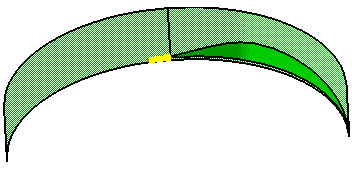Face Checker | ||
| ||
The options selected and the numerical values entered in the dialog box are modal within the session.
Face Checker
- Internal Edges
- If Internal Edges is not selected, the analysis is done on the surfaces.
- If Internal Edges is selected, the analysis is done on the faces of the surfaces.
Example: A Face Checker analysis has been performed on GeometricalSet.2 that contains Join.1. Holes have been found.
- If Internal Edges is not selected, the complete join is transferred to Hole_0.001.1 because the whole surface is considered as erroneous.
- If Internal Edges is selected, only an extract of the join is transferred to Hole_0.001.1, this extract corresponds to the erroneous face.
- Self-Intersection
- Displays faces found with self-intersections
in yellow. The search for self-intersections is done with an editable self-intersection
tolerance.
This self-intersection tolerance is a tolerance used to determine whether
the edges of the boundary are going to collide,
for example as if they were displayed as lines with this thickness.

Example:
- Let's have a closer look at the face
below. It is found as self-intersecting.

- Its supporting surface is recalled from the No Show. This is a
cylinder, that has no self-intersection. This implies that the self-intersection problem comes from the
boundary.

- Below is the analysis of the intersection between boundary
portions body recalled from the No Show.
We have drawn a portion of both edges of the boundary, and created the
intersection between them
(portion between the two circles on the left).

- Transfer is performed with the Automatic Repair check box selected. The face repaired is no longer self-intersecting.
The proposed Self-Intersection tolerance is 0.001mm, as in the Join command.
- Let's have a closer look at the face
below. It is found as self-intersecting.
- Hole
- Displays faces with holes in the boundary in blue.
The Face Checker searches discontinuities in the boundaries of faces or surfaces, like in the Apply Geometrical Display.
- If the distance between two consecutive curves is less than the threshold value, there is no discontinuity in the boundary.
- If the distance between two consecutive curves is higher than the threshold value, there is a discontinuity.
The proposed discontinuity tolerance is 0.01 mm whereas it is 0.001 mm in Apply Geometrical Display.
- Thin Face
- Detects thin faces and displays them in pink.The search for thin faces is done with an editable tolerance. This tolerance is used to determine whether the face would still exist if its boundaries were displayed with a line of this thickness.
- Transfer
- Transfers erroneous faces to a new Geometrical Set.
- Number of anomalies
- Indicates the number of self-intersecting faces found.
- Anomalies Detected
- Lists the defective sites.
- Transfer to
- Proposes a Geometrical Set into that you can transfer the sites. The name of the transfer Geometrical Set is made of the name of the type of problem and of the value of the tolerance used to search the problem. You can edit this name.
- Automatic Repair